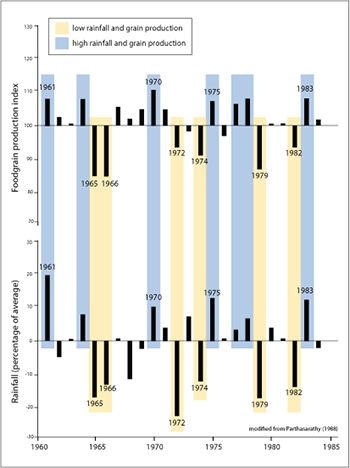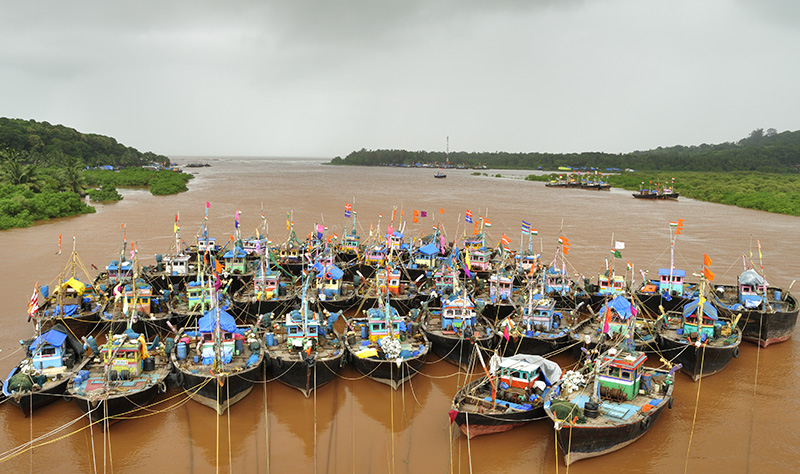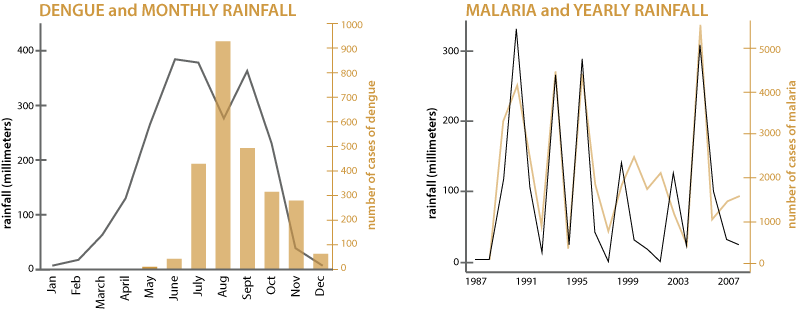Impacts on agriculture and economy
Farmers in monsoon regions rely on the wet summer months to grow crops. However the summer monsoon does not always bring the same amount of rainfall, and variations in rain have implications for agriculture and the economy.
For example, in 2009 very little rain fell during the summer monsoon in India. In some areas rainfall was half of what is typical during the wet season and farmers could not plant their crops. Farm animals starved; many were sold for a fraction of what they would have normally been worth because farmers were desperate.

From wheat and rice to vegetables, cotton, and tea, Indian farmers grow a wide range of crops and the country uses more land for crops than any other country in the world (215 million acres). Crops depend on rain and, in India, more than three quarters of the annual rainfall occurs during the four months of the summer monsoon season. But during years when there is less rainfall than usual, crops die in the fields or cannot be planted at all. Take a look at the graphs to the left to see how the amount of grain crops produced by farmers in India (including wheat, rice, and barley) relates to the amount of rainfall. Over half of India’s population works in agriculture, and monsoon rains directly affect their incomes and livelihood. Agriculture adds up to more than 15% of India’s Gross Domestic Product (GDP), which means that when crops fail because of too little rain, the economy suffers.
While too little rainfall during the summer monsoon can cause dire conditions for farmers on land, too much rainfall and overly strong winds can make coastal waters unsafe, preventing fishermen throughout South Asia from heading to sea to catch the fish they depend on for income.
Monsoon rains can be harnessed as hydropower, a valuable energy resource. Hydropower currently provides 25% of India’s electricity. Reservoirs are filled during the summer monsoon rains and then the water is gradually released through dams, turning turbines to create electricity year-round. During years when there is little monsoon rainfall, the reservoirs are not replenished, limiting the amount of hydroelectric power produced during the year.

Monsoons and health
Because regions with a monsoon climate have distinctly wet and dry seasons, they are prone to floods and droughts, both of which are hazardous to health.
During summer monsoons, heavy rainfall can cause flooding. Powerful floodwaters can drown victims and damage buildings, leaving people without homes and vulnerable to the elements. During the 2014 summer monsoon in Pakistan and India, nearly 300 people lost their lives during landslides and home collapses. Australia’s 2011 monsoon flooding caused about $4.5 billion in damage.
Yet the main health hazards during summer monsoon season are diseases like cholera, dengue, chikungunya, and malaria, as well as stomach and eye infections. Each year, as the summer monsoon season approaches, Indian hospitals prepare for high numbers of patients with these illnesses.

When floods cause water purification systems to become compromised, diseases like cholera can spread through unclean drinking water. Also, mosquitos that carry disease breed in open containers that fill with rainwater – from large water barrels and ponds to small coconut shells. Mosquitos that spread malaria, dengue, and chikungunya are common in the tropics. Because mosquitoes have more places to breed during the summer monsoon rains, there are more mosquitos. That leads to more mosquito bites that spread disease.
During the winter, clouds rarely provide shade and the dry land surface can’t cool off by evaporation, so heat waves are common. At least 2500 people died in a major heat wave that swept across India in 2015, and over 1000 died about a month later from a heat wave in Pakistan. Temperatures in New Delhi were near 120°F (almost 50°C). Water is scarce at this time of year, which causes water-washed diseases to become common; these diseases spread when there is too little water for proper hygiene.
Meningitis, which kills one in ten victims, spreads during the dry season in sub-Saharan Africa when desert dust becomes airborne and is inhaled. Typically the number of cases drops with the first monsoon rains.
The number of people affected by both the wet and dry monsoon seasons depends on the population of the affected region. For example, Mali in West Africa has a fast-growing population and researchers are investigating how people will cope with the same limited water resources during the dry season as the country’s population grows.
Explore more:
Great article! It helped me a lot in my research!
Cool. It helped me too.
awsome very talanted article written 5 stars all round you are such a gem
yeeeeeeeeeeeeeeeeeeeeeeeeet Ithelped me with my homework totally thank you so much author !!!! xDDDD
It helped me !
same here
Not so good
Super stuff!
it helped i guess but not a lot to the point where i found it to be helpful.
Helped me alot
GREAT STUFF!
helped me with multipul assignments
multiple*
not so helpful
Goood stuff
awsome helped me with my work
helped tones
helped me with homework
SUPER STUFF! its really informative and this helped me a lot in my research . THANK YOU!
Helped me with my homework thanks
inredibly helpful. helped me with my research ─ thank you!
thanks it helped me in making presentation
Lame the stats are incorrect and boring
thanks helped with my prodgect!
me too!
Thank you! great info!
Well what can I say, basically the geography bible!!!!! Would 100% recommend to any family members 5*’s 😉
It’s good not so bad
This is super cool to learned about this 😀
Great article helped me with my homework
thanks for the help